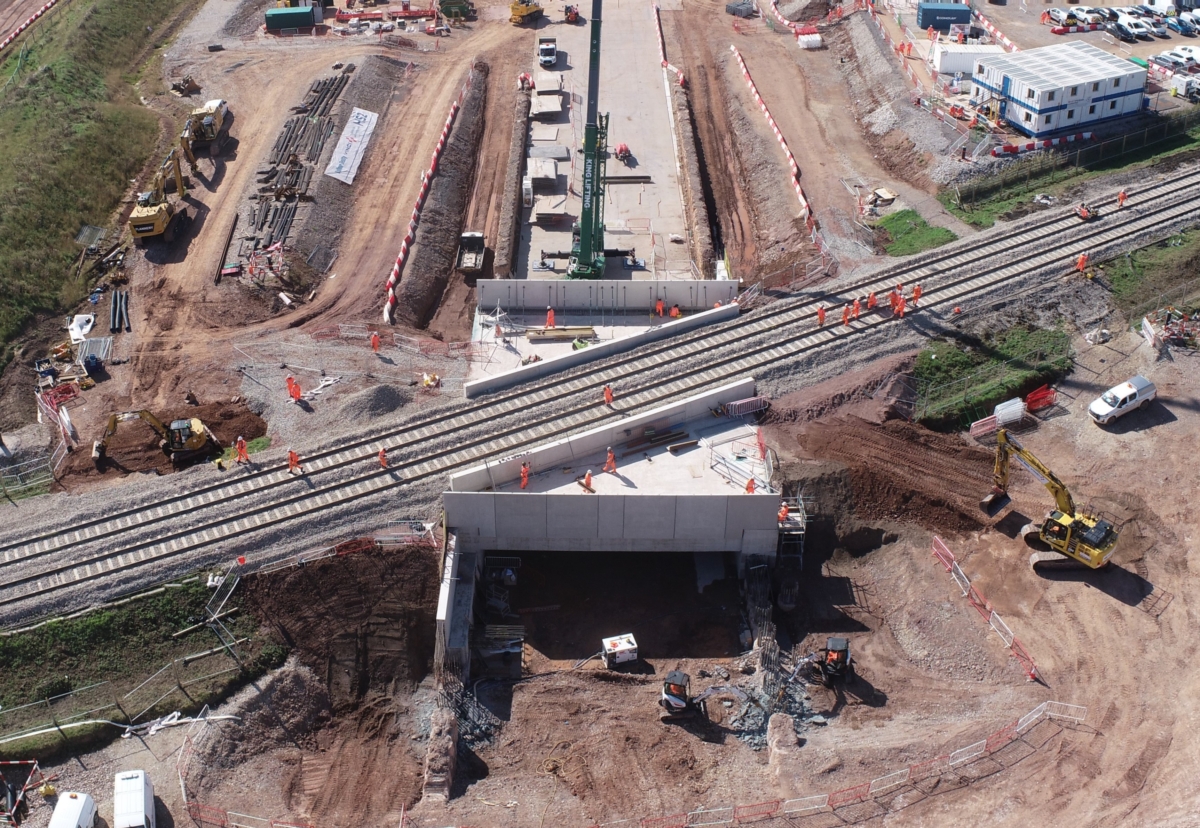Contractors on HS2 have completed a ‘marathon’ bridge build at Streethay near Lichfield involving 18 specialist construction companies.

Work involved excavating 14,000 tonnes of earth, building a 140 metre retaining wall and moving a 2,600 tonne bridge deck 130 metres into place under the South Staffordshire freight railway.
The work was carried out during a 10 week blockade. It was completed by HS2’s civils contractor in the West Midlands, Balfour Beatty VINCI, and designers Mott MacDonald as part of a Design Joint Venture with SYSTRA (MMSDJV), together with teams from 18 specialist supply chain companies.
At the end of July, the 2,600 tonne bridge deck, which had been cast on land adjacent to the railway was moved 130 metres into position using self-propelled modular transporters.
Since then, each side of the bridge was backfilled, the rail tracks were reinstated, with the railway line was successfully handed back to Network Rail last week and now reopened.
The 25 metres long and 18 metres wide Streethay overbridge sits within HS2’s Streethay cutting and will enable HS2 trains to travel under the existing railway between Birmingham and Crewe.
Through design development, Mott MacDonald engineers were able to reduce the total length of wall structures for the railway at Streethay from 1.6 kilometres to 420 metres, meaning 80% less concrete is needed – saving around 420,000 tonnes of carbon, supporting HS2’s ambition to cut carbon on the project.
The Streethay bridge sits on top of the larger 420 metre long retaining wall structure which will have two additional bridges crossing it – the south bound A38 slip road bridge, and the Rykneld Bridge which carries the A38 north bound slip road and the A38 north and south bound carriageway.
At its peak, over 150 people worked on the complex construction operation, with teams from 18 specialist companies, delivering design, surveys, piling works, bridge build, concrete pouring, crane operations, reinforcements, modular transportation, track and systems removal and reinstatement.
The work was delivered in parallel to the construction of the nearby Fulfen Wood bridge, which involved moving a giant 6,200 tonne single span structure under the West Coast Main Line – the UK’s heaviest drive to install an intersection bridge.
David Millar, Rail Interface Manager at Balfour Beatty VINCI said: “The successful delivery of this complex and challenging piece of engineering near Lichfield is another proud moment for Balfour Beatty VINCI on the HS2 project.
“It’s only been possible thanks to the skill, dedication and support shown by the project team over the past few years, including our supply chain. Together, we’ve had to work around existing transport infrastructure, including the South Staffordshire freight railway and the A38, making this achievement even more rewarding.”
Prior to the railway blockade, retaining walls were installed on either side of the railway, enabling the areas to be excavated. The bridge deck was constructed on land adjacent to the existing railway, 130 metres from its final position.
Once the railway was closed to freight trains, the track and embankment were removed. Bachy Soletanche Balfour Beatty Ground Engineering joint venture then installed an additional 76 secant piles measuring 1.3 metres diameter and 30 metres deep, linking to the piles they installed prior to the blockade, to create two retaining walls which act as the walls for the bridge.
A concrete capping beam was installed over the retaining walls, then the bridge was moved into place using self-propelled modular transporters with 344 wheels. Concrete was poured to attach the deck to the capping beam, the embankment was back filled using 2,500 tonnes of structural backfill, on either side of the bridge, before the railway line was reinstated.
The 18 companies which delivered the project were:
J. Murphy & Sons constructed the bridge deck and the concrete elements during the blockade
Bachy Soletanche Balfour Beatty Ground Engineering JV (SB3) undertook all piling works, both before and during the blockade
The bridge parapets were made by Explore precast
Podtrak and RSS Infrastructure delivered rail systems work
Balfour Beatty VINCI delivered earthworks
Pile break-down was by Pile Breaking Systems UK Ltd
Trackway supplied by TPA
Jacking the structure and modular transportation by Mammoet UK
Survey works track monitoring by Aecom
Crane supply by King Lifting supported by BBV lifting teams
Concrete provided by CEMEX
Reinforcement by ROM – specialist reinforcement manufacturers
Temporary works by RMD
Permanent works design by Design JV (Mott Macdonald and Systra)
Temporary works design by Taylor Woodrow





